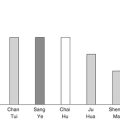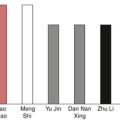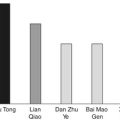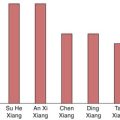Chapter Eleven. Herbs that regulate the Blood
 |
1. What are the causes of Blood stagnation? What are the indications for herbs that promote the Blood circulation?
Herbs that promote the Blood circulation are used for treating syndromes of Blood stagnation. There are different degrees of Blood stagnation. In a mild case, the Blood moves more slowly than it should. If the situation does not change, the Blood stagnates. In a severe case, congealed Blood may be complicated with Phlegm, Heat or Cold, and forms a solid mass that blocks the Blood circulation.
Blood stagnation is caused by several factors. First, both Heat and Cold can lead to Blood stagnation. Heat consumes the Blood and makes it thicker so that the movement of the Blood slows; Cold contracts Blood and lets the Blood circulation slow down. Secondly, Qi stagnation caused by emotional disturbance, stress, anger, excessive pondering or depression over a long period of time can directly result in Blood stagnation. Thirdly, trauma or fracture may directly cause Blood stagnation in the locality. Moreover, Wind, Dampness and Cold that remain for too long in the meridians can also cause Blood stagnation. Accumulation of Phlegm, water, food or parasites in the body for a long period of time may also lead to Blood stagnation. Finally, if the Qi and Blood are deficient, they are not able to promote the Blood circulation so they will also lead to Blood stagnation.
The main symptoms of Blood stagnation are localized pain of a deep, colicky or sharp nature that worsens at night. In severe cases, a solid, immobile mass can be found. Patients who suffer from stagnation of Blood for a long time may have symptoms such as a dark complexion, purple lips and nails, dry skin, amenorrhea, psychiatric disorders, fragile nails and hair. The tongue body is purple with purple spots at the tip or border, and the pulse is wiry and choppy.
In clinical practice, the syndrome of stagnation of Blood can be found in diseases such as myocardial infarction, angina pectoris, acute cholecystitis, biliary ascariasis, acute pancreatitis, acute appendicitis or intestinal obstruction, trauma, strain, sequelae of cerebrovascular accident, rheumatic fever and rheumatoid arthritis, as well as different tumors.
2. What are the characteristics of herbs that promote the Blood circulation?
The Blood circulation needs certain conditions. Blood prefers slight warmth and needs an unobstructed pathway. Too much Cold or Heat may cause pathological changes. Cold can freeze the Blood and results in stagnation. Heat consumes Blood and makes it thicker, so also causes stagnation. Meanwhile, Heat lets the Blood move faster and leave its normal pathway, causing bleeding.
Herbs that promote Blood circulation have the following characteristics according to the physiologic and pathological characteristics of Blood.
Pungent, aromatic and slightly warm
Pungency has a moving ability, aromatic smell can penetrate turbidity and reach the deep layers of the body, and warmth may accelerate the actions of the pungent and aromatic properties. Most herbs that promote the Blood circulation are pungent and slightly warm. Such herbs are Chuan Xiong ( Chuanxiong rhizoma), Ji Xue Teng ( Spatholobi caulis et radix), Hong Hua ( Carthami flos), Su Mu ( Sappan lignum), Yan Hu Suo ( Corydalidis rhizoma), Wu Ling Zhi ( Trogopterori faeces), Ru Xiang ( Olibanum) and E Zhu ( Curcumae rhizoma).
Pungent, bitter and slightly cold
Since pungency is able to activate the Blood, and bitterness and Cold can clear Heat and prevent Blood consumption from Heat, these herbs are especially suitable for treating Heat in the Blood and Blood stagnation no matter which pathological factor is the initial cause. The commonly used herbs are Dan Shen ( Salviae miltiorrhizae radix), Yu Jin ( Curcumae radix), Yi Mu Cao ( Leonuri herba) and Chi Shao Yao ( Paeoniae radix rubra).
Pungent, bitter and salty
If congealed Blood exists in the body for a long period of time, it becomes a hard clot or solid mass, and special herbs must be applied to promote Blood circulation as well as to reduce, disperse or dissolve congealed Blood. Since pungency has a dispersing nature, and bitterness and saltiness are able to soften hardness, these properties are often found in herbs that break up or drive out congealed Blood. Such herbs are San Leng ( Sparganii rhizoma), E Zhu ( Curcumae rhizoma), Ru Xiang ( Olibanum), Mo Yao ( Myrrhae), Wa Leng Zi ( Arcae concha), Shui Zhi ( Hirudo), Mang Chong ( Tabanus)* and Zhe Chong ( Eupolyphaga seu opisthoplatia)*.
Entering the Heart, Pericardium, Liver and Gall Bladder meridians
The Heart governs the Blood and promotes the Blood circulation. The Liver regulates the amount of Blood in the Blood circulation. As the Pericardium and Gall Bladder are externally–internally related to the Heart and Liver, most of the herbs that promote Blood circulation enter these meridians. Such herbs are Chuan Xiong, Dan Shen, Yue Ji Hua ( Rosae chinensis flos), Tao Ren ( Persicae semen) and Hong Hua.
Herbs are divided into different degrees according to the strength of promoting the Blood circulation and removing congealed Blood
Herbs that invigorate the Blood and promote the Blood circulation
These are used for the syndrome of Blood stagnation. The commonly used herbs are Chuan Xiong, Dan Shen, Yue Ji Hua, Yan Hu Suo ( Corydalidis rhizoma) and Hong Hua.
Herbs that dissolve and dissipate congealed Blood
These are used to treat more severe or chronic syndromes of Blood stagnation, in which the Blood becomes thicker and blood clots are formed. The commonly used herbs are Wu Ling Zhi, Dan Shen, Yu Jin, Ze Lan ( Lycopi herba), Yi Mu Cao ( Leonuri herba) and Yue Ji Hua.
Herbs that open the meridians and collaterals and dissolve congealed Blood
These are used to treat chronic Blood stagnation when the meridians and collaterals are blocked for a long period of time. They are particularly used in chronic Bi syndrome. The commonly used herbs are Si Gua Luo ( Luffae fructus), Wang Bu Liu Xing ( Vaccariae semen) and Lu Lu Tong ( Liquidambaris fructus).
Herbs that break up and drive out congealed Blood
These are used to treat severe Blood stagnation, in which a solid and immobile mass is formed. The commonly used herbs are Tao Ren, Ru Xing, Mo Yao, San Leng ( Sparganii rhizoma) and E Zhu.
Herbs that soften hardness and break up or drive out congealed Blood
These are used to treat a solid mass that is formed by congealed Blood, Phlegm, Dampness, Cold or Heat and toxin. The commonly used herbs are Mu Li ( Ostrea concha), Wa Leng Zi ( Arcae concha), Shui Zhi ( Hirudo), Zhe Chong ( Eupolyphaga seu opisthoplatia)* and Mang Chong ( Tabanus)*.
Relieving pain
The pathology of pain in TCM is blockage of the Qi and Blood. Chronic, deep and stubborn pains especially are caused by Blood stagnation; herbs that promote Blood circulation are able to reduce Blood stagnation and open up the meridians, thus relieving pain. The herbs that are particularly effective for relieving pain are Yan Hu Suo, Chuan Xiong, Wu Ling Zhi and Pu Huang ( Typhae pollen).
Topical usage
Trauma directly causes stagnation of Blood, manifesting as pain, swelling or bleeding in the locality. Herbs that promote Blood circulation are the main part of the treatment when the bleeding has stopped. These herbs can be used not only orally but also topically, such as in lotions, ointments, tinctures and plasters. The commonly used ones are Tao Ren, Hong Hua, Ru Xiang, Chuan Xiong and Dan Shen.
Usage for Bi syndrome
When Wind, Dampness, Cold or Heat invades the meridians, they block the Qi and Blood circulation. Herbs that promote Blood circulation can enhance the actions of the other herbs of expelling Exterior pathogenic factors. In chronic Bi syndrome, there is always Blood stagnation, so the herbs that regulate the Blood are often used in formulas. The commonly used herbs are Chuan Xiong, Su Mu ( Sappan lignum), Chuan Niu Xi ( Cyathulae radix) and Jiang Huang ( Curcumae longae rhizoma).
3. What precautions should be observed when using herbs that promote the Blood circulation?
Herbs that promote the Blood circulation should not be used during pregnancy, in bleeding conditions or during profuse menstruation. Because these herbs are pungent, they let the Blood circulate quickly, and break up congealed Blood or soften hardness. These actions may cause miscarriage and cause heavier bleeding.
Herbs that promote Blood circulation can be used with caution in the following conditions.
Heavy menstruation, miscarriage and bleeding caused by stagnation of Blood
There is a saying: ‘If the congealed Blood is not removed, the new Blood is impossible to grow. If the congealed Blood is not removed, the Blood cannot turn back to the normal pathway in the bleeding conditions.’ Herbs that promote the Blood circulation can be used for the purpose of stopping bleeding, such as that seen in ectopic pregnancy, pregnancy with metropolypus or uterus myomatosus, adenomyosis or bleeding of a tumor. However, the dosage and course of treatment must be controlled by experienced practitioners.
Patients with weak Spleen and Stomach
As all herbs that promote Blood circulation are quite strong in taste and easily injure the Stomach, the herbs should be taken after meals, especially in patients with chronic Bi syndrome, who have already used Western medicine for a long time, or whose Stomach has been injured too.
Patients with weakness of Qi
Herbs that invigorate the Blood circulation may also activate the Qi movement and these actions can consume the Qi. The herbs should not be used alone when patients suffer from Qi deficiency. The side-effect of herbs that move the Blood is manifested as tiredness after using these herbs. In this situation, herbs that strengthen the Qi and Blood should also be used.
Selecting proper herbs from the strength scale to treat a specific case of Blood stagnation
It is very important to select the correct herbs from the strength scale to treat syndromes of Blood stagnation. If the stagnation is severe, and the applied herbs are too gentle, the congealed Blood will not be eliminated. If the Blood stagnation is mild but the prescribed herbs are very strong, the Qi and Blood can be injured.
The proper herbs should be selected according to the condition and constitution of the patient, the location and nature of the stagnation of Blood, and considering the duration of the disease.
4. What are the characteristics of Chuan Xiong ( Chuanxiong rhizoma)?
Chuan Xiong is pungent and warm, and enters the Liver, Gall Bladder and Pericardium meridians. Pungency can disperse congealed Blood, and warmth can activate the Blood circulation and dissipate its obstruction. Chuan Xiong is a very effective herb for invigorating the Blood and promoting its circulation. It is characterized by high moving speed and strength. It moves upwards, downwards, inwards and outwards, and can reach every part of the body, so it is regarded as ‘the herb that moves the Qi in the Blood’.
In clinical practice, it is often used to remove congealed Blood and stop pain. It is particularly effective in the treatment of headache when the pain is in the sides of the head, such as in headache caused by stress or migraine. It is also used to relieve pain in intercostal neuralgia, coronary heart disease and stenocardia, trauma and arthritis. Since it can reach any part of the body, it can be used to treat cold and cramping pain of the fingers and toes, dysmenorrhea, amenorrhea and irregular menstruation, which are caused by Qi and Blood stagnation complicated by Cold. Combined with other herbs it can be prescribed for Excess, for Deficiency, for Cold or for Heat syndromes.
Although Chuan Xiong is effective for promoting the Blood circulation, it can cause the Qi and Blood to ascend rapidly; therefore it should not be used in patients who suffer from syndromes of Liver-Yang rising, or Liver-Fire or Heart-Fire blazing up—for instance, as seen in hypertension, glaucoma and cerebrovascular accident. Moreover, since this herb is warm and very pungent, a large dosage may consume the Yin and Qi. Patients with Yin deficiency or with a weak constitution should not use this herb in large dosages.
5. What are the characteristics of Dan Shen ( Salviae miltiorrhizae radix)?
According to the relationship of Qi and Blood in TCM, Dan Shen is often used with herbs that spread the Liver-Qi, such as Chai Hu ( Bupleuri radix), Xiang Fu ( Cyperi rhizoma) and Qing Pi ( Citri reticulatae viride pericarpium) in treating Blood stagnation syndrome. It is also used with herbs that reduce Liver-Fire and Heart-Fire such as Long Dan Cao ( Gentianae radix) and Lian Qiao ( Forsythiae fructus) in syndromes of Heat in the Liver and Heart meridians.
6. What are the differences between Chuan Xiong ( Chuanxiong rhizoma) and Dan Shen ( Salviae miltiorrhizae radix) in promoting the Blood circulation?
Chuan Xiong and Dan Shen are able to promote the Blood circulation and both are commonly used for treating Blood stagnation syndrome. They can effectively relieve pain in the chest and hypochondriac region, pain due to trauma and Bi syndrome.
Chuan Xiong is pungent and warm, and its speed of movement is greater than that of Dan Shen. Its action is also stronger in invigorating the Blood, removing congealed Blood and opening up the meridians.
Dan Shen is bitter and cold; it cools the Blood and moderates the speed of the Blood circulation. Its functions are stronger in dissolving congealed Blood, relieving chest pain, calming the Mind and eliminating irritability than those of Chuan Xiong.
In syndromes complicated by Cold and Heat, stagnation of Qi and Blood, these two herbs can be used together.
7. Dan Shen ( Salviae miltiorrhizae radix) and Yu Jin ( Curcumae radix) can both cool the Blood and promote its circulation. What are the differences between their functions?
Dan Shen and Yu Jin are bitter and cold, and enter the Heart and Liver meridians. Both are able to promote the Blood circulation, remove congealed Blood and stop pain. They can also calm the Mind to treat irritability and hypochondriac pain. In clinical practice, they are often used together to treat coronary heart disease, hepatitis, cholecystitis and hepatosplenomegaly.
Dan Shen primarily enters the Heart meridian. Compared with Yu Jin, its function focuses more on the Heart, and it can directly clear Heat in the Heart, cool the Blood and calm the Mind.
Yu Jin primarily enters the Liver meridian. It is not only bitter and cold, but also pungent. Its function focuses more on the Liver meridian and its action in invigorating the Liver-Blood is stronger than that of Dan Shen. Because of the rapidity of its action, it is regarded as ‘the herb that moves the Qi in the Blood’. Its action in removing the congealed Blood is also stronger than that of Dan Shen, and it is considered as a herb that is able to break up congealed Blood. It can be used in formulas that treat dysmenorrhea, mastopathia, liver cirrhosis and tumors.
Furthermore, Yu Jin is colder than Dan Shen. It can not only cool the Blood, but also stop bleeding. It is an aromatic herb and is able to penetrate Damp-Heat, clear Damp-Heat and promote bile secretion. In clinical practice, Yu Jin is used for treating Damp-Heat in the Upper Jiao and Middle Jiao. The symptoms are fullness in the chest and epigastric region, jaundice and reduced appetite, such as in malaria and hepatitis. In addition, Yu Jin can spread the Liver-Qi, clear the Liver-Heat and eliminate irritability, as well as treat headache and a tight sensation in the chest caused by Damp-Heat obstruction.
8. What are the differences between Yi Mu Cao ( Leonuri herba) and Ze Lan ( Lycopi herba)?
Yi Mu Cao and Ze Lan have similar functions. Both can promote Blood circulation, remove congealed Blood, increase urination and reduce edema. They are the important herbs for treating gynecological disorders and are used for irregular menstruation, amenorrhea, dysmenorrhea, abdominal pain after giving birth and difficult urination. However, there are differences between their properties that influence their applications.
‘ Yi’ means ‘benefit’, ‘ Mu’ means ‘mother’ and ‘ Cao’ means ‘grass’. The function of this herb is therefore described in its name: ‘a plant that benefits mothers’. Yi Mu Cao is pungent, bitter and cold, and enters the Heart and Liver meridians. Pungency has a dispersing ability, and bitterness and Cold can reduce Heat, so this herb can disperse and descend congealed Blood and clear Heat in the Blood. It can be used in many gynecological disorders caused by Blood stagnation and Heat in Blood, such as pelvic inflammation, ovarian cysts, salpingitis, endometritis and endometriosis. It can also be used in bleeding conditions where Blood stagnation is present, such as is seen in menorrhagia and uterus myomatosus.
Ze Lan is pungent and bitter, and enters the Liver and Spleen meridians. Pungency and bitterness can disperse and descend congealed Blood. Unlike Yi Mu Cao, Ze Lan is slightly warm and is able to promote Blood circulation and break up obstructions. It is characterized as removing congealed Blood without the side-effect of injuring the normal Blood, and it is especially suitable for treating stagnation of Blood caused by Cold in the Lower Jiao and in the Blood. It is also an aromatic herb and is able to spread the Liver-Qi and the Spleen-Qi, so it is an excellent herb for treating stagnation of Liver-Qi and Blood and in both Excess and Deficiency cases. In clinical practice, it is often used in menopausal syndrome, irregular menstruation, premenstrual tension, depression, hepatitis and chronic urinary tract infection.
9. What are the characteristics of Hong Hua ( Carthami flos), Ling Xiao Hua ( Campsitis flos), Yue Ji Hua ( Rosae chinensis flos) and Mei Gui Hua ( Rosae flos)?
These four herbs are all flowers, and all enter the Liver meridian and enter the Blood. They have the function of invigorating the Blood and promoting its circulation. They are often used for treating disorders of menstruation that are due to stagnation of the Liver-Qi and Blood. However, there are differences between their functions.
Hong Hua is pungent and warm, and enters the Heart and Liver meridians. It is the strongest herb of the four for invigorating the Blood and promoting its circulation. If a small dosage is applied, it can regulate the Blood circulation; if a large dosage is applied, it can break up the congealed Blood and stop pain. It can be used for treating syndromes of Blood stagnation, such as seen in uterus myomatosus, endometriosis, amenorrhea, dysmenorrhea, irregular menstruation and infertility. Because it can move the Blood strongly, it may cause bleeding or make it heavier, so the dosage and treatment course should be controlled carefully. During menstruation, this herb should be used in a smaller dosage or stopped for 3 days to avoid heavy menstrual bleeding. As well as treating menstrual disorders, Hong Hua is one of the commonly used herbs to treat trauma. It is effective for reducing swelling and pain. In this case, it can be used both orally and topically.
Ling Xiao Hua is pungent and slightly cold, and enters the Liver and Pericardium meridians. It not only can disperse stagnant Blood and regulate menstruation, but can also cool the Blood, expel Wind and relieve itching. Therefore it is suitable for treating the syndrome of Wind-Heat disturbance in the Blood, in which patients suffer from itching all over the body that worsens with warmth.
Yue Ji Hua is sweet and warm, and enters the Liver meridian. It has a fragrant smell. It can regulate not only the Blood circulation, but also the Liver-Qi. It is a good herb for treating irregular menstruation, premenstrual tension depression, menopausal syndrome and hepatitis due to stagnation of the Liver-Qi and Blood.
Mei Gui Hua is sweet, slightly bitter and warm. Like Yue Ji Hua, it can promote both Qi and Blood circulation of the Liver and is used for treating many gynecological disorders. However, it is characterized as harmonizing the Liver-Qi and Stomach-Qi and is used particularly for the syndrome in which stagnant Liver-Qi attacks the Stomach. The symptoms are fullness in the chest, epigastric and hypochondriac regions, irritability and reduced appetite.
10. Yan Hu Suo ( Corydalidis rhizoma) and Wu Ling Zhi ( Trogopterori faeces) are commonly used herbs for alleviating pain. What are the differences between them?
Yan Hu Suo and Wu Ling Zhi enter the Liver and Spleen meridians. Both are able to promote Blood circulation and remove congealed Blood. They are very effective for relieving pain.
Yan Hu Suo is pungent, warm and slightly bitter. It is characterized as entering the Qi and Blood level, and promoting the Qi movement and Blood circulation. It is an excellent herb for relieving pain and its action is steady and strong. In clinical practice, it can be used alone and in TCM is considered to be a painkiller. If it is fried with a little vinegar, this increases its effect in relieving pain.
Wu Ling Zhi is bitter, sweet and warm. It can promote Blood circulation and stop pain but its action is gentler and slower than that of Yan Hu Suo. However, unlike Yan Hu Suo, it has no function in promoting Qi movement. The strong point of this substance is that it dissolves congealed Blood in a gentle but a constant way. It is effective for removing congealed Blood without the side-effect of injuring the normal part of the Blood, so it is used for chronic diseases in which congealed Blood is not easily and quickly removed. In clinical practice, it is often prescribed in formulas for treating gynecological disorders and liver diseases.
11. What are the differences between Chuan Niu Xi ( Cyathulae radix) and Huai Niu Xi ( Achyranthis bidentatae radix)?
The growing habitat of Chuan Niu Xi is Si Chuan province; Huai Niu Xi is from the region of the Huai River. Both herbs are bitter, sour and neutral, and enter the Liver and Kidney meridians. Although they have the same name in Chinese, they are actually from two different plants and are different in their functions.
Chuan Niu Xi is characterized as promoting the Blood circulation and directing the Blood downwards. It can treat amenorrhea, abdominal mass, headache and dizziness. It is also effective for directing Heat and Fire downwards, so it is often used for treating hot flushes, headache, dizziness, blurred vision in menopausal syndrome, hypertension and cerebrovascular accident. These disorders are caused by deficiency of the Liver-Yin and Kidney-Yin, and uprising of the Liver-Yang, Liver-Heat, Qi and Blood.
Huai Niu Xi is slightly sweet and sour. It has the function of tonifying the Liver and Kidney, strengthening the tendons and bones, treating weakness in the legs and knees, difficulty in walking and edema in the legs. It has no function in promoting Blood circulation.
12. What are the characteristics of Dang Gui ( Angelicae sinensis radix) and Ji Xue Teng ( Spatholobi caulis et radix) in the function of promoting Blood circulation?
Dang Gui and Ji Xue Teng are sweet, slightly bitter and warm, and enter the Liver meridian. Like the other herbs that promote the Blood circulation, they can invigorate the Blood and treat syndromes of Blood stagnation. The differences between these two herbs and the other herbs that promote Blood circulation are that Dang Gui and Ji Xue Teng are able to tonify the Blood and can treat Blood deficiency. Because of this characteristic, these two herbs are particularly suitable for treating syndromes of deficiency of Blood and stagnation of Blood, such as is seen in chronic disease or in patients with a weak constitution.
Unlike Dang Gui, Ji Xue Teng also enters the Kidney meridian. ‘Vines enters collaterals’, according to the concept of traditional Chinese herbal medicine, so this herb is able to regulate the collaterals and to treat numbness, stiffness and cramping of the limbs and is often used for treating chronic arthritis, the sequelae of cerebrovascular accident and other vascular and neurological diseases.
13. What are the indications for herbs that cool the Blood and regulate its circulation?
There are several herbs that have the ability of promoting the Blood circulation and cooling the Blood, such as Chi Shao Yao ( Paeoniae radix rubra), Mu Dan Pi ( Moutan cortex), Yi Mu Cao ( Leonuri herba), Dan Shen ( Salviae miltiorrhizae radix) and Yu Jin ( Curcumae radix). All of them are cold in nature, and enter the Heart or Liver meridians. Since all of them enter the Blood level, they are able to promote the Blood circulation, cool the Blood, and to treat Heat in the Blood and stagnation of the Blood. Meanwhile, these herbs are also used in internal Heat syndromes to prevent the stagnation of Blood in conditions of Heat consuming the Blood. They can be used together or separately. However, there are some differences when they are applied in clinical practice.
Chi Shao Yao is sour, bitter and slightly cold. It is characterized as reducing Excess-Heat in the Blood and regulating the Blood circulation. It can also reduce swelling and pain. In clinical practice, Chi Shao Yao is used to treat abscess, furunculosis, appendicitis, intestinal obstruction and dysmenorrhea. It can also be used topically to treat pain and swelling due to trauma.
Mu Dan Pi is characterized as reducing Empty-Heat in the Blood and regulating the Blood circulation. In clinical practice, it is particularly suitable for treating the syndrome in which Heat disturbs the Blood in conditions of Yin and Blood deficiency. It is used to treat low-grade fever, ‘bone-steaming’ fever, skin rashes, nose bleeding, blood in the sputum and subcutaneous bleeding.
Yi Mu Cao treats particularly the stagnation of Blood in the Lower Jiao and it is often used for gynecological disorders, such as dysmenorrhea, amenorrhea, irregular menstruation and inflammations.
Dan Shen primarily enters the Heart meridian and is especially effective for clearing Heat in the Heart and promoting the Blood circulation in the chest; it therefore treats irritability, restlessness, palpitations, insomnia and chest pain.
Yu Jin primarily enters the Liver meridian and is especially suitable for clearing Heat and promoting the Blood circulation from the Liver. It is more often used for treating hypochondriac pain due to long-term depression, in premenstrual tension and diseases of the liver and gall bladder.
14. What are the differences between Ru Xiang ( Olibanum) and Mo Yao ( Myrrhae)?
Ru Xiang and Mo Yao are aromatic herbs. They are very bitter and pungent, and move quickly. They can strongly disperse congealed Blood and direct it to descend, open up the meridians and collaterals, and are very effective for relieving pain. The two herbs are often used together to enhance the therapeutic effect. In clinical practice, they are often applied to reduce pain and swelling in trauma, arthritis and fractures.
Ru Xiang is warm and pungent, and enters the Heart and Liver meridians. Compared with Mo Yao, it promotes not only the Blood circulation, but also the Qi movement. It can also relax tendons. Ru Xiang is especially suitable for conditions where the joints and muscles are very stiff, swollen and painful. It is also more often used topically than Mo Yao.
Mo Yao is neutral and it enters the Liver meridian. Compared with Ru Xiang, it is more bitter and its dispersing action is also stronger. This herb is stronger than Ru Xiang for breaking up congealed Blood and is used not only in trauma and fracture, but also for hard masses, such as tumors.
As both herbs have a strong smell and may easily cause nausea and vomiting, and overdose may injure the Stomach, they are better used in pills or capsules.
15. What are the differences between San Leng ( Sparganii rhizoma) and E Zhu ( Curcumae rhizoma)?
San Leng and E Zhu are two important herbs that remove congealed Blood and treat tumors. They can strongly promote the Qi movement and Blood circulation, and break up congealed Blood. The two herbs are often used together to enhance their actions because San Leng is stronger in breaking up congealed Blood and E Zhu is stronger in breaking up the restraint of Qi. They are used to treat severe Blood stagnation. In clinical practice, they can be used to treat hepatosplenomegaly, liver cirrhosis, ectopic pregnancy and cancer.
Since San Leng and E Zhu can strongly break up congealed Blood, they can also injure the Qi. When treating patients with Qi deficiency or with a weak constitution, these herbs must be used together with herbs that tonify the Qi.
16. What are the functions of Zhe Chong ( Eupolyphaga seu opisthoplatia)*, Shui Zhi ( Hirudo) and Mang Chong ( Tabanus)*
These three substances are insects and they are also poisonous. All of them enter the Liver meridian and are able to break up congealed Blood, soften hardness and reduce masses. They are used in the treatment of hepatosplenomegaly, liver cirrhosis and tumors.
In the action of breaking up congealed Blood, Zhe Chong is the weakest of the three and Mang Chong is the strongest. However, all of them can cause the side-effect of injuring of the Qi and Blood. They should be used with caution and, in patients with Deficiency syndromes, combined with herbs that tonify the Qi and Blood.
17. What are the characteristics of Wang Bu Liu Xing ( Vaccariae semen) and Di Long ( Pheretima)?
Wang Bu Liu Xing and Di Long are commonly used substances to open up the collaterals. They can eliminate congealed Blood from the collaterals and promote Qi movement and Blood circulation there. They are often used for treating chronic pain, stubborn pain, tingling, stiffness or numbness in the limbs, such as in migraine, sequelae of cerebrovascular accident and other neurological disorders.
However, Wang Bu Liu Xing is also effective for opening up the collaterals of the Liver and Stomach, and promoting secretion of milk, and is used for lack of milk after giving birth owing to stagnation of the Liver-Qi. Di Long is effective in expelling Wind from the meridians and collaterals and is often used in Bi syndrome.
18. Which herbs can be applied topically?
Since herbs that promote the Blood circulation are also good for reducing swelling and relieving pain, many of them can also be used topically in lotions, ointments, tinctures and plasters. Herbs for topical use should be finely ground, easily dissolved or mixed with water, oil or another vehicle, not be irritant to the skin or wounds, and not cause toxic or allergic reactions. The commonly used herbs are Tao Ren ( Persicae semen), Hong Hua ( Carthami flos), Ru Xiang ( Olibanum), Chuan Xiong ( Chuanxiong rhizoma) and Dan Shen ( Salviae miltiorrhizae radix).
Comparisons of strength and temperature in herbs that regulate the Blood
 |
| Fig. 11.1. |
| Comparison of the herbs that promote Blood circulation, stop pain and are warm in temperature. Ru Xiang ( Olibanum), Mo Yao ( Myrrhae), San Qi ( Notoginseng radix), Yan Hu Suo ( Corydalidis rhizoma), Chuan Xiong ( Chuanxiong rhizoma), Hong Hua ( Carthami flos), Pu Huang ( Typhae pollen), Wu Ling Zhi ( Trogopterori faeces) , Jiang Huang ( Curcumae longae rhizoma), Chuan Niu Xi ( Cyathulae radix), Yue Ji Hua ( Rosae chinensis flos), Ji Xue Teng ( Spatholobi caulis et radix), Ze Lan ( Lycopi herba). |
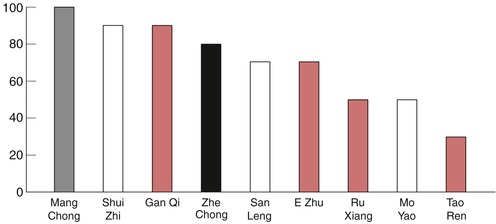 |
| Fig. 11.2. |
| Comparison of the herbs that break up congealed Blood. Mang Chong ( Tabanus)*, Shui Zhi ( Hirudo), Gan Qi ( Toxicodendri resina), Zhe Chong ( Eupolyphaga seu opisthoplatia)*, San Leng ( Sparganii rhizoma), E Zhu ( Curcumae rhizoma), Ru Xiang ( Olibanum), Mo Yao ( Myrrhae), Tao Ren ( Persicae semen). |
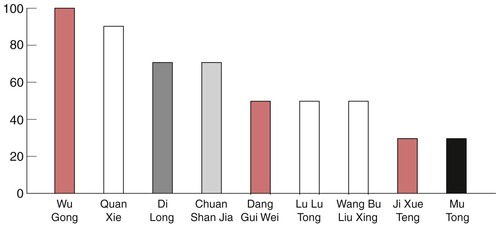 |
| Fig. 11.3. |
| Comparison of the herbs that open up the collaterals. Wu Gong ( Scolopendra)*, Quan Xie ( Scorpio), Di Long ( Pheretima), Chuan Shan Jia ( Manitis squama)**, Dang Gui Wei ( Angelicae sinensis radix extremitas), Lu Lu Tong ( Liquidambaris fructus), Wang Bu Liu Xing ( Vaccariae semen), Ji Xue Teng ( Spatholobi caulis et radix), Mu Tong ( Mutong caulis)* |
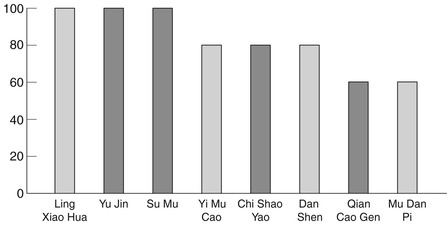 |
| Fig. 11.4. |
| Comparison of the herbs that invigorate the Blood and are cold in temperature. Ling Xiao Hua ( Campsitis flos), Yu Jin ( Curcumae radix), Su Mu ( Sappan lignum), Yi Mu Cao ( Leonuri herba), Chi Shao Yao ( Paeoniae radix rubra), Dan Shen ( Salviae miltiorrhizae radix), Qian Cao Gen ( Rubiae radix), Mu Dan Pi ( Moutan cortex). |

